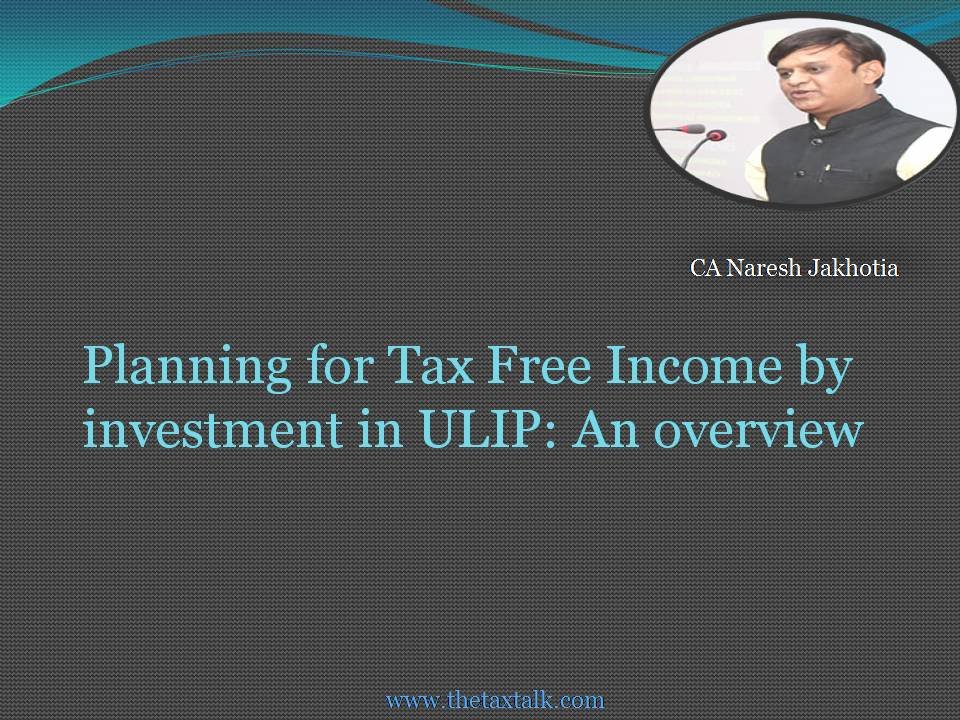![]()
Planning for Tax Free Income by investment in ULIP: An overview
There are only two things which are certain in life – Death and Taxes. Though both are unavoidable, its impact can be planned & managed suitably. Saving Tax is one of the fundamental rights of the taxpayer. Tax planning through investment is one of the most powerful tools. Passive income of the earning person results in higher tax liability. Tax impact can be reduced by making investment in instruments that yields tax free income i.e. Exempt income. By investing the amount in such a way that the accrual of income is deferred or exempt income is received results in optimum tax management. One such available option could be by making investment in the Unit-Linked Insurance Plan (ULIPS) issued by life insurance companies. ULIP has reported significant growth in recent times. Let us know about ULIP and its comparison with the Mutual Fund Investment:
- ULIP has almost the same benefit & feature as is offered by mutual funds. ULIP, like mutual funds, invests the amount in equity / debt funds. ULIP is a combination of a life insurance cover & mutual fund.
- The amount invested in Ulip is eligible for tax deduction U/s 80C subject to a maximum of Rs 1.50 lakh a year but with a condition that premium should not exceed 10% of the sum assured.
Mutual funds don’t carry any tax benefit u/s 80C except investment in Equity Linked Saving Scheme (ELSS) which is eligible for deduction u/s 80C up to Rs. 1.50 Lakh. - Taxation of ULIP post amendment by the Finance Act-2021:
The tax implication of ULIP varies significantly as compared to mutual funds. It has a special tax treatment as under:
a)The proceeds received on the death of the individual by its nominee is also tax-free. - b)Under section 10 (10D) of the income-tax Act, if the sum assured in a life insurance policy is at least 10 times the annual premium & the annual premium doesn’t exceed Rs. 2.50 Lakh then the entire proceeds from the policy (whether at the time of maturity or surrender after 5 years) will be completely tax free. [Income Tax Act-1961 has been amended by the Finance Act-2021 w.e.f. 01.04.2021 so as to limit the tax exemption of high value ULIP products. The exemption on maturity proceeds of Ulip has been removed if the annual aggregate premium exceeds Rs 2.50 lakh. However, the amount received from all the ULIP policies issued prior to 31.03.2021 will continue to be exempt from tax irrespective of the amount of premium paid or the amount received.].
In short, the tax exemption is now only available for investment up to Rs 2.50 lakh only. In case investment in ULIP exceeds Rs. 2.50 Lakh, Long-term capital gains (LTCG) tax will be applicable like other equity-oriented investments i.e., LTCG over Rs 1 lakh in a financial year is taxed at 10% and short term capital gain tax at 15% is levied on overall gains (holding period less than 12 months).
- Both, mutual funds as well as ULIP levy a fund Management Chargefor its maintenance which keeps varying. Mutual funds don’t provide for life insurance cover whereas ULIP provides for life cover. Since, life cover is inbuilt in ULIP, it deducts mortality charges from the amount invested. As a result, the fund invested reduces to that extent.
- There is no lock in period in the case of Mutual Funds in general. However, tax saving mutual funds i.e., ELSS carry a lock in period of 3 years. For ULIP, higher lock in period of 5 years is there.
- Mutual funds, be it equity oriented mutual fund or debt fund or hybrid fund, are in the tax net. ULIP will continue to enjoy the tax exemption subject to the amount ceiling of Rs. 2.50 Lakh mentioned above. Higher the returns from share market, higher would be the effect of tax saving from ULIP in comparison to Mutual funds.
- ULIP is a multi-year commitment. The buyer has to keep paying the premium for the full term of the plan. There is no such constraint in the case of mutual funds where the option to invest or not to invest has enough flexibility.
- The switching facility is now aptly incorporated by the insurance companies in the ULIP product. As a result, investors can switch from equity to debt and vice-versa without incurring a tax liability. In mutual funds, such switch over attracts tax implications. The best part is that switches between the different funds within a ULIP are tax-free whereas it is not so in case there is a switch from one scheme to another scheme. In the case of mutual funds, such redemption or switches attract tax.
- Though ULIP charges are higher, it is the cost of the life insurance cover provided to the investor. “No tax label” on ULIP policies up to Rs. 2.50 Lakh p.a. has a cost attached to it in the form of mortality charges (i.e., insurance cost). However, charges levied in ULIP are well rationalized over a period of time, making it equally efficient.
Conclusion:
From the perspective of personal taxation, ULIP can be a worthy investment. Considering the direct tax benefit for investment up to Rs. 2.50 Lakh p.a., ULIP may be considered as a nice investment option in comparison to ELSS & Mutual fund. To be more calculative, so long as mortality & other charges are less than 10.40% (i.e., effective rate of LTCG tax) of anticipated income from ULIP, it would be advisable to prefer ULIP over Mutual Fund.
[Readers may forward their feedback & queries at nareshjakhotia@gmail.com. Other articles & response to queries are available at www.theTAXtalk.com]


